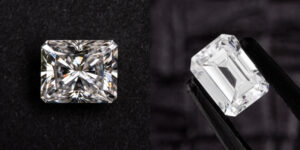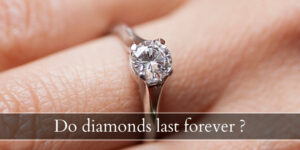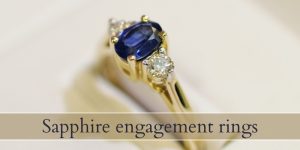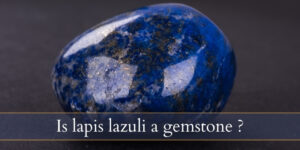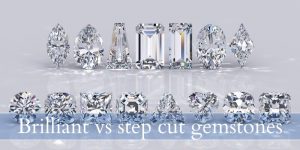Sapphires and emeralds are two of the oldest, most sought-after gemstones in the world. Aside from their famous colors, these gems also offer class and elegance to any piece of jewelry. If you find yourself having to choose between the two, read on for a comparison.
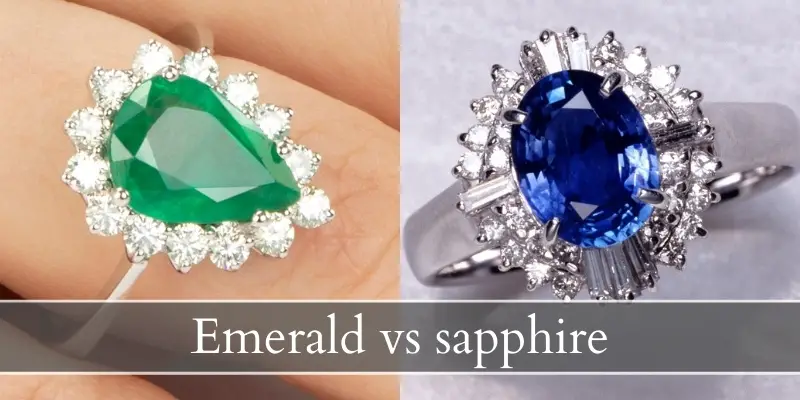
Sapphire vs emerald
Sapphires are harder and stronger than emeralds, and are composed of a wholly different material. Where an emerald is usually green, sapphires come in many colors with blue being the best-known. If looking to buy one, sapphires often end up more affordable than emeralds of the same size, cut, and quality.
There is also the cut style to take into account, as sapphires can take any cut style due to their structure. Emeralds work best with step-cuts such as emerald or Asscher.
1. Sapphires are a bit tougher than emeralds
On the Mohs scale of hardness you’ll find that sapphires are harder and more scratch resistant than emeralds. Where a sapphire scores a 9.0 an emerald ranges between 7.5-8.0.
What does this mean for your jewelry ? It means that an emerald is more likely to scratch and develop tiny fractures if worn daily and exposed to the elements, compared to a sapphire. It also means that a sapphire will scratch an emerald, if they ever come into contact.
But for everyday wear, know that all gems over 7.0 are fine. Some may need to be kept out of direct sunlight, such as amethyst, but neither emerald nor sapphire have this issue.
Both emeralds and sapphires tend to be heavily included, so an eye-clean one won’t be easy to find. But you may have them heat-treated or oiled to remove or mask most inclusions.
2. Emeralds tend to be green, sapphires may vary in color
Probably the first thing you notice, the difference in color between emeralds and sapphires is significant. Emeralds are a type of beryl, which is naturally white or transparent. But if trace amount of vanadium are present, a green color will develop. These gems tend to be perfectly green, regardless of how dark or light the shade is. If there is a secondary hue, it’s usually bluish.
Sapphires on the other hand come in many colors, but the most common and well-known one is the deep royal blue, or cornflower blue. In most cases sapphires have to be heat treated to achieve a better, deeper color. Other sapphire colors include white, yellow, orange, pink, and in some cases a blue-green.
Read also: Ruby VS Spinel
3. Sapphires are far more affordable than emeralds
Both sapphires and emeralds are rare gems, but somehow emeralds are more costly. The following are simply prices to guide yourself by, and we are not affiliated in any way with gemsny.com. The following links are only there to provide an example.
For example a 1 ct emerald of vivid color, slightly included, untreated goes for about $10,700.
A 3 ct emerald that is also vivid green, slightly included, and has standard treatment goes for $35,700 !
A 1 ct sapphire that is intense blue, untreated, goes for $4,700. One that is also 1 ct but heat-treated is slightly less, for $3,100.
Meanwhile a 3 ct sapphire, intense blue, untreated sells for $16,200. That’s half the price of a similarly sized emerald.
You can therefore imagine that any piece of jewelry that you commission is going to be at least twice as expensive if made with emeralds, than with sapphires. In case of selling your jewelry, you’ll get a much better price for an emerald than for a sapphire.
4. Emeralds are best in step cuts, sapphires in brilliant cuts
Because emeralds grow in a specific structure style (trigonal), so simpler, more geometrical shapes are going to be easier to cut than one with multiple facets. Another key point is that emeralds are heavily included and thus can be pretty brittle. To mitigate this, the emerald cut was developed.
An emerald cut mimics an emerald’s natural structure, while still providing some facets to allow light tot rave through the gem. A brilliant cut such as a cushion or a round brilliant is more difficult for an emerald gem.
Sapphires are much sturdier and can thus be cut in nearly any shape and cut style. The most common sapphire cut is a brilliant cut, though you can find it in a step cut as well. The emphasis on both emeralds and sapphires is on the color intensity and clarity, so a step cut brings these to light.
Emerald and sapphire meaning
If you’re wondering what each gemstone means, know that both emeralds and sapphires have a long, long history and often have conflicting meanings, and sometimes share a meaning.
For example emerald has often been associated with power, regeneration, calm, reflection, rebirth, and part of these meanings are simply because the gem appears green.
Sapphires are thought to bring calm, peace, loyalty, and when it comes to love they have conflicting meanings. Some people claim sapphires soothe emotions and inspire loyalty in romance, bringing luck. Others claim a sapphire is bound to ruin your love life and result in tragedy. One thing is clear though: sapphire have a deep connection to love for many people, though not everyone agrees it’s a positive connection.
You may have noticed some common themes between these two gems, such as peace and serenity and stillness. Both green and blue are cool colors, and for most people these are very calming colors that invite reflection and a bit of meditation.
Compromise: green sapphires
A good compromise between sapphires and emeralds are green sapphires. They do exist, though that’re not easy to find. Their shade of green is very different from an emerald green. Where an emerald is deep forest green, a green sapphire has some blue undertones that give it a cooler green color.
One of the best examples we could find was an eye-clean green sapphire, that was heated, and is a whopping 7.9 cts ! It goes for $14,000 which is still half the price of a 3ct emerald. Smaller carat green sapphires, slightly included, can be found for even less, like $9,700 and $7,300.
There is no mistaking the green sapphire with the green emerald. But if you want a sapphire’s resistance to scratches and better clarity, but need your gemstone to be green, then a green sapphire is a better option.
Below we’ll give you a couple more examples of other green gems you can use in place of emerald, if a green sapphire is too expensive.
Alexandrite
Alexandrite comes in many, many, many colors and you can easily find it in green. The problem is finding a shade of green that closely matches emerald green. Green alexandrite is usually blue-toned, so it will be similar to a green sapphire. Alexandrite
Tsavorite (green garnet)
A fancy name for green garnet, tsavorite is a deep, vivid green that can out-green even an emerald in some cases. It’s fairly easy to find in the right shade.
Peridot
Peridot has a golden hue to it, so it’s rather an olive green sort of green. If you’re not very picky abut the shade of green then this gemstone may be what you’re looking for.
Tourmaline
Tourmaline has great clarity and comes in various colors, just like alexandrite. But, it’s just a bit more affordable than alexandrite.
Cubic zirconia
A bit of a cheat, but if you’re looking for a very specific shade of green and cannot find it in any other gem, your best bet is to go for cubic zirconia. They’re tough and they’re much more affordable that other gems, so you’re going to have an easier time. Best of all, you can choose the exact color you want since cubic zirconia comes in any color you like.

I’m the main author for jewelrymaterialguide.com. I started this site after we did tons of research before our wedding and noticed that there is information about rings, jewelry, and so on that is really hard to find on the internet.

